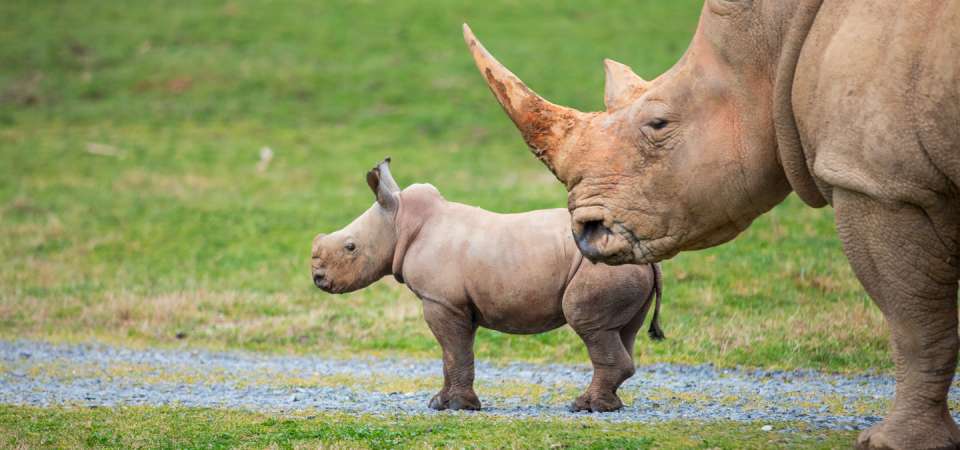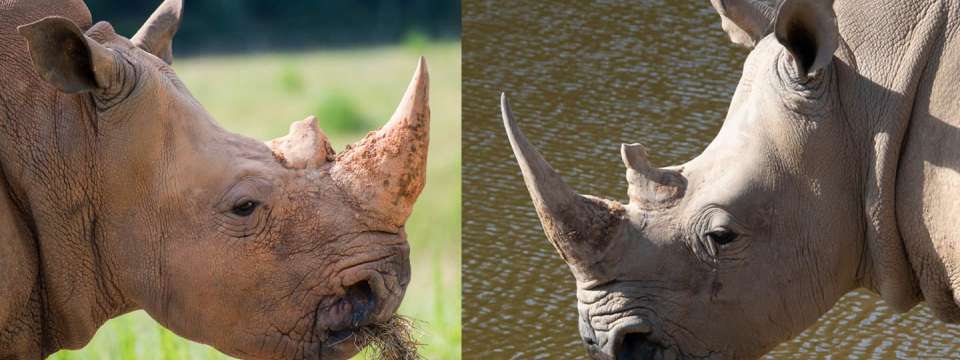
Sunny Weekend Alert
The Zoo anticipates high attendance on sunny weekends. Parking is limited, so arrive early, carpool, and check our site / social pages often for more updates!
The Zoo anticipates high attendance on sunny weekends. Parking is limited, so arrive early, carpool, and check our site / social pages often for more updates!

Written by Brett Williams, Research Intern, North Carolina Zoo
If you're like me, you've probably seen every show on TV at this point. To get my fill of entertainment, I head to the North Carolina Zoo to binge-watch my favorite family drama. I'm, of course, referring to the Zoo's Southern white rhinoceros crash.
A group of rhinos is called a "crash," and rightly so! You see, even in their swanky 40-acre Watani Grasslands habitat at the Zoo (Fig. 1), they inevitably run into each other as part of their daily social interactions. What's even better, I get to watch this riveting "show" for five hours a day, twice a week, as part of my master's project at North Carolina State University. My name is Brett Williams, and I am studying the social lives of the rhinos at the Zoo.

Watani Grasslands is a 40-acre habitat, home to 9 species, including our southern white rhino crash (Figure 1).
Southern white rhinoceros are the most common species of rhino under human care and are quite social animals. In the wild, moms and calves will typically separate themselves from other rhinos for up to two years until they are weaned. However, older calf-less females are known to form close friendships with other females, either pairing off with a single "bestie" or grazing in a group. What makes our crash special is that while most zoos may house no more than three rhinos at a time, the Zoo houses nine; yes, nine! Our crash is rarer because it comprises grandmothers, aunts, mothers, daughters, and sisters, making it multigenerational. We even have two moms with new calves, which means we are in a unique position to examine some unanswered questions. Do rhinos maintain close relationships with their offspring after the youngsters are weaned? Do rhinos exhibit close social bonds with aunts/nieces? And what do relationships look like in unrelated rhinos?
To answer these questions, first, I have to identify who's who, which is easier said than done! I primarily tell them apart by their horn shape, as they each have their own unique shape (Fig. 2). Unfortunately, this can get tricky when giving themselves a nose-job as easy as getting a haircut. Rhino horns grow continuously and are made of keratin, just like our fingernails and hair, so they will often rub their horns on rocks and trees for some natural rhinoplasty. This means, as a researcher, I have to keep up with what their horns look like, as they change over time. Their habitat is so big that I sometimes need to use binoculars or a high-powered spotting scope to see their horns from a distance, making me look more like a paparazzo than a fan.

Pictured Above: Side by side, the horns of Kit and Abby are very different in shape and size! Horn shape is used to identify individuals (Fig. 2).
Once all the rhinos have been identified, the fun begins. Every half-hour, I randomly select one of the rhinos to be my "focal subject" for collecting data. At each two-minute interval during this half-hour period, I record the behaviors of the focal animal. Monthly, I pull all my data together and examine how each individual spends their days and who they interacted with the most.
So far, we have been able to see some fascinating developments in the rhinos' behaviors. The two moms and their young calves exhibit the strongest social bonds, as the calves stay close and nurse throughout the day (Fig. 3). Surprisingly, the moms do not maintain strong bonds with their older offspring. More generally, it appears as though individuals do not choose social partners based on relatedness at all! In fact, our strongest social relationships are between pre-adolescent and adult rhinos, suggesting age difference drives sociality in rhinos.

Pictured Above: Our two moms, Kit and Linda, with their most recent calves, Jojo and Mguu (Figure 3).
The function of these associations could be explained by several factors, including the young rhino seeking to gain environmental information from older individuals and potential protection from predators. As we continue with this project, we will monitor the changes in these bonds as the calves begin to wean and the adolescents mature.
We hope the Zoo can use this research and maybe help other zoos understand the social structure of their rhinos. This can hopefully help lower their stress while meeting their natural social needs. I look forward to seeing what season two has in store for this cast of characters! Stay tuned!